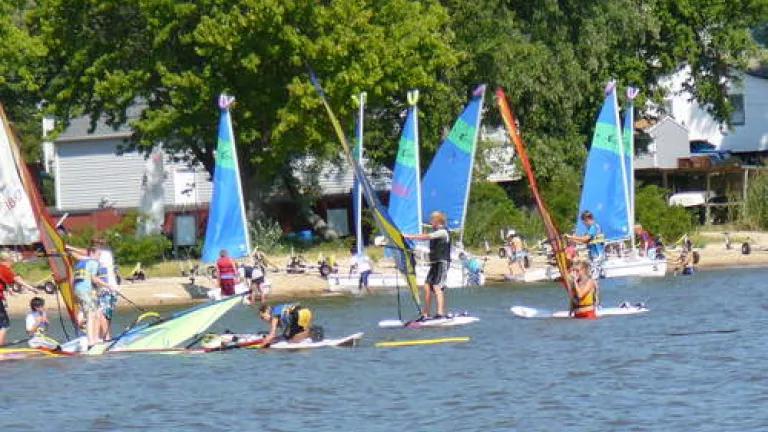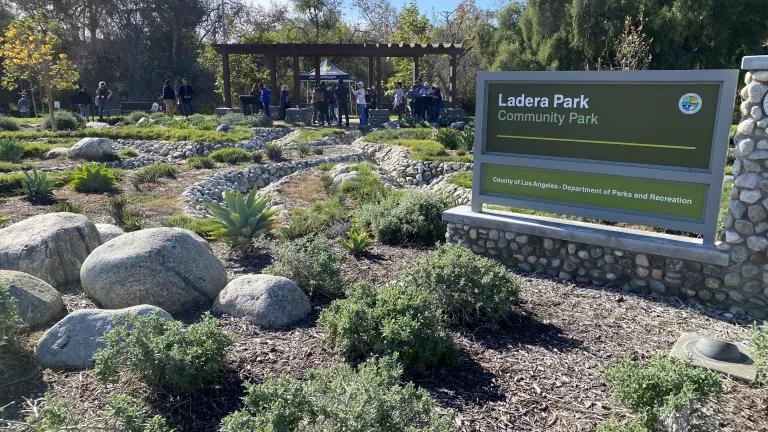
If you live anywhere in the mid-Atlantic region, or even if you don't, you probably know that there's a massive effort underway to clean up the Chesapeake Bay. All six states whose lands drain into the Bay, along with the District of Columbia, are working with the federal government to reduce the pollution that's fouling the Bay's waters. Over the next decade, this effort will restore the Chesapeake, the nation's largest estuary and a true national treasure.
But sometimes, in tackling such a huge problem, we forget that the Bay's ecosystem is made up of many smaller waterways: local rivers and streams that our communities cherish, use, and want to protect.
The Back River in Baltimore, Maryland is one of those waters. It flows through a highly urbanized watershed in Baltimore City and Baltimore County. Altogether, its 73 miles of waterways are home to numerous marinas and waterfront parks, including Cox's Point Park and Rocky Point Park. Locals can often be found hanging out at the public picnic areas, boat ramps, and fishing piers overlooking the river.
Windsurfers at Rocky Point State Park, at the mouth of the Back River. Photo credit: Maryland Department of the Environment (MDE)
Unfortunately, like the Bay itself, the Back River has become badly polluted by excess nutrients (nitrogen and phosphorus) and sediment, among other harmful substances. This pollution has caused the river and its tributaries to become so contaminated that they're unsafe for recreation, fishing, and other uses. Baltimore City and County are developing plans to reduce pollution in the Back River watershed as part of the Chesapeake Bay clean-up effort, but they need help from the private lands that are sending massive amounts of polluted runoff into the Back's waters every time it rains.
That's why NRDC, American Rivers, and Blue Water Baltimore submitted a petition to the U.S. Environmental Protection Agency (EPA) today asking the agency to require certain types of private properties to reduce the amount of stormwater pollution they send into the Back River.

Stormwater gushing into Herring Run, a tributary of Back River. Photo credit: Bay Journal
Why is stormwater such a problem for the Back River? Certain types of land uses (commercial, institutional, and industrial sites) generate a lot of pollution because they tend to have a lot of impervious area, mainly in the form of parking lots and rooftops. These impervious areas produce large amounts of runoff containing very high levels of sediment, nutrients, and other contaminants. But most of these sites are not required to do anything about the mess they're making. Instead, the responsibility for cleaning it up has fallen to local governments that are struggling to meet federal pollution reduction mandates.
The highly urban Back River watershed has a particularly large number of these sites. Our analysis of the watershed found that:
- Commercial, institutional, and industrial ("CII") sites occupy 21.6% of the land area that flows into the Back River. Most of these sites are located within a half-mile of the river or one of its tributary streams.
- Modeled results indicate that, out of all urban stormwater sources, CII sites generate at least 33% of phosphorus loadings, 42% of nitrogen loadings, and 46% of sediment loadings to the river.
- CII sites cover about 15% of the watershed with impervious surface, which disrupts the hydrologic cycle and generates large volumes of runoff. Scientific research has shown that watersheds become degraded above 5-10% imperviousness. (Overall, the entire Back River watershed is 25-35% impervious.)
- Studies suggest that CII sites are alone contributing triple the pollution that the Back River would receive from the entire watershed under natural conditions.

The Back River watershed. Image credit: Maryland Department of the Environment
Maryland has adopted pollution control standards for new development and redevelopment projects, which help to reduce runoff from those sites. But sites developed before the year 2000, when the standards were adopted, didn't have to do anything to reduce their runoff pollution. Baltimore County records indicate that as much as 88% of the watershed was already developed prior to that time. That's a lot of land area with minimal or no pollution controls in place - which helps to explain how the Back River got to be in such bad shape in the first place.
You may be wondering: what about the fact that these private landowners are already paying a stormwater fee to Baltimore City and Baltimore County? Isn't that enough? No, it's not.
Those fees, which have been the subject of so much debate in Maryland, are often not enough to cover the cost of pollution clean-up. And it's just not efficient - or fair - to ask the government to clean up the pollution that private parties are creating, especially when the City and County don't control and can't access the land where the runoff is coming from. It makes much more sense for the sites creating the pollution to take action themselves. If they do, they should be eligible for discounts from their stormwater fees under existing City and County programs.
In the words of our partners at Blue Water Baltimore:
"Even with new stormwater utility fee revenue, we know that local government capacity to address restoration requirements is stretched thin. Further, we know that most of the potential stormwater restoration opportunities are located on private land. Stormwater pollution is more efficiently treated at its source, which is the property where is it generated. Not enough public land is available to capture and treat the tremendous quantity of stormwater that flows off of parking lots at big-box stores and college campuses into our publicly-owned streets, storm drains, and streams."
--David Flores, Blue Water Baltimore

A rain garden installed to reduce stormwater pollution at an urban site in Baltimore. Photo credit: Chesapeake Stormwater Network
The legal basis for our petition is a provision in the Clean Water Act known as "residual designation authority," or RDA. According to the Act, if EPA determines that a category of stormwater discharges is contributing to water quality violations, the agency must exercise its residual designation authority and require those dischargers to apply for permits. Those permits must then require the sites to limit the amount of pollution in their runoff, such as by mandating actions or steps that they must undertake. Ideally, the permits would require the sites to implement green infrastructure practices that capture rain where it falls and prevent stormwater pollution at the source.
The intended result is cleaner water, greener and healthier neighborhoods, and ultimately, improved quality of life in Baltimore. Exercising RDA and requiring private properties to do their fair share would also be a more equitable and fair allocation of clean-up responsibility than the system we have now.
NRDC and our partners filed similar petitions two years ago that requested permits for commercial, industrial, and institutional sites in larger geographical regions. EPA denied those petitions because the agency claimed that we hadn't shown that CII sites were causing water quality problems in any particular watershed. We take issue with EPA's conclusions, which lacked scientific foundation and seemed more like an excuse to dodge responsibility for controlling this kind of pollution. Today, we're calling the agency's bluff and filing new petitions in four specific watersheds (Back River and three others across the country) where the evidence is clear that these types of sites are responsible for local water quality impairments.
Information about our other petitions can be found here:
- Army Creek (New Castle County, Delaware)
- Dominguez Channel (Los Angeles, California)
- Los Cerritos Channel (Los Angeles, California)
We believe these petitions will prove that RDA is a critical legal tool that can be used to establish clean-up requirements for stormwater pollution dischargers in urban watersheds nationwide.




